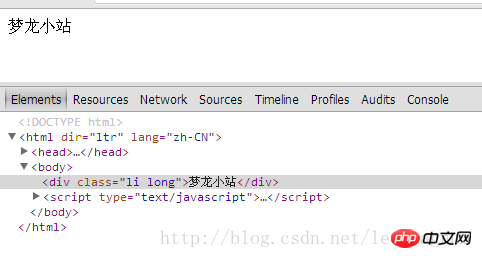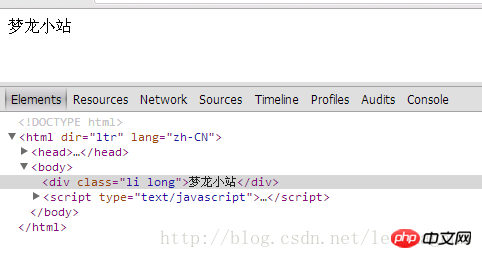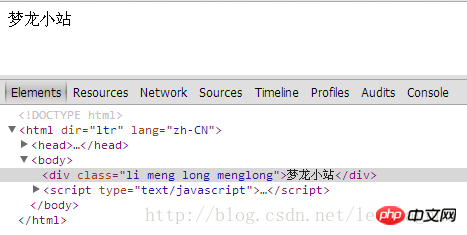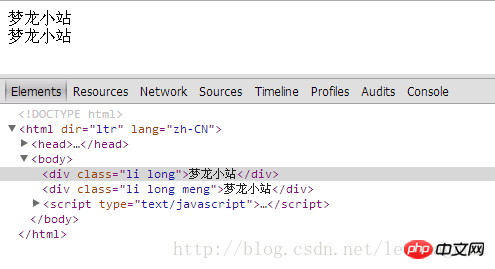classList attribute in HTML5
[Introduction] Previously we introduced some newly added selectors in HTML5, namely querySelector(), querySelectorAll() and getElementsByClassName(). These three have their own unique functions. If necessary, you can read the relevant content in HTML5 actual combat and analysis. Today, I have introduced to you some newly added selectors in HTML5, namely querySelector(), querySelectorAll() and getElementsByClassName(). These three have their own unique functions. If necessary, you can read the relevant content in HTML5 actual combat and analysis. Today I will introduce to you the classList attribute.
What exactly does the classList attribute do? Let’s leave classList alone for now. We consider the question, that is, how do we delete one of the class names among elements with multiple class names? Menglong struggled with his brain and finally came up with a way to achieve it. Delete the class name meng among the three class names li, meng and long. The code is as follows
HTML code
<p class="li meng long">梦龙小站</p>
- JavaScript code
//获取要删除类名meng的p
var p = document.getElementsByTagName("p")[0];
//获取类名字符串并拆分成数组
var allClassName = p.className.split(" ");
//找到要删除的类名
var i, len,
pos = -1;
for(i=0, len = allClassName.length; i < len; i++){
if(allClassName[i] == "meng"){
pos = i;
break;
}
}
//删除类名
allClassName.splice(pos, 1);
alert(allClassName) //li,long
//将其余的类名拼成字符串并重新添加到元素的类名中
p.className = allClassName.join(" ");
Preview effect

<p class="li meng long">梦龙小站</p>
//获取要删除类名meng的p
var p = document.getElementsByTagName("p")[0];
alert(p.classList) //li meng long
p.classList.remove("meng")
alert("p.className: " + p.className) //p.className: li long 
<p class="li meng long">梦龙小站</p>
//获取要删除类名meng的p
var p = document.getElementsByTagName("p")[0];
alert(p.classList.contains("meng")) //true
alert(p.classList.contains("menglong")) //false 3. add(value)
HTML code
<p class="li meng long">梦龙小站</p>
//添加类名 menglong
//获取要删除类名meng的p
var p = document.getElementsByTagName("p")[0];
p.classList.add("menglong");
alert("p.className: " + p.className) //p.className: li meng long menglong 
<p class="li meng long">梦龙小站</p>梦龙小站
//切换类名 meng
//获取要删除类名li的p
var p = document.getElementsByTagName("p");
var i, len;
for(i=0, len = p.length; i< len; i++){
p[i].classList.toggle("meng");
}
alert("p[0].className: " + p[0].className) //p[0].className: li long
alert("p[1].className: " + p[1].className) //p[1].className: li meng long 
The above is the detailed content of classList attribute in HTML5. For more information, please follow other related articles on the PHP Chinese website!

Hot AI Tools

Undresser.AI Undress
AI-powered app for creating realistic nude photos

AI Clothes Remover
Online AI tool for removing clothes from photos.

Undress AI Tool
Undress images for free

Clothoff.io
AI clothes remover

Video Face Swap
Swap faces in any video effortlessly with our completely free AI face swap tool!

Hot Article

Hot Tools

Notepad++7.3.1
Easy-to-use and free code editor

SublimeText3 Chinese version
Chinese version, very easy to use

Zend Studio 13.0.1
Powerful PHP integrated development environment

Dreamweaver CS6
Visual web development tools

SublimeText3 Mac version
God-level code editing software (SublimeText3)

Hot Topics
 Explain JSON Web Tokens (JWT) and their use case in PHP APIs.
Apr 05, 2025 am 12:04 AM
Explain JSON Web Tokens (JWT) and their use case in PHP APIs.
Apr 05, 2025 am 12:04 AM
JWT is an open standard based on JSON, used to securely transmit information between parties, mainly for identity authentication and information exchange. 1. JWT consists of three parts: Header, Payload and Signature. 2. The working principle of JWT includes three steps: generating JWT, verifying JWT and parsing Payload. 3. When using JWT for authentication in PHP, JWT can be generated and verified, and user role and permission information can be included in advanced usage. 4. Common errors include signature verification failure, token expiration, and payload oversized. Debugging skills include using debugging tools and logging. 5. Performance optimization and best practices include using appropriate signature algorithms, setting validity periods reasonably,
 How do you parse and process HTML/XML in PHP?
Feb 07, 2025 am 11:57 AM
How do you parse and process HTML/XML in PHP?
Feb 07, 2025 am 11:57 AM
This tutorial demonstrates how to efficiently process XML documents using PHP. XML (eXtensible Markup Language) is a versatile text-based markup language designed for both human readability and machine parsing. It's commonly used for data storage an
 Explain late static binding in PHP (static::).
Apr 03, 2025 am 12:04 AM
Explain late static binding in PHP (static::).
Apr 03, 2025 am 12:04 AM
Static binding (static::) implements late static binding (LSB) in PHP, allowing calling classes to be referenced in static contexts rather than defining classes. 1) The parsing process is performed at runtime, 2) Look up the call class in the inheritance relationship, 3) It may bring performance overhead.
 PHP Program to Count Vowels in a String
Feb 07, 2025 pm 12:12 PM
PHP Program to Count Vowels in a String
Feb 07, 2025 pm 12:12 PM
A string is a sequence of characters, including letters, numbers, and symbols. This tutorial will learn how to calculate the number of vowels in a given string in PHP using different methods. The vowels in English are a, e, i, o, u, and they can be uppercase or lowercase. What is a vowel? Vowels are alphabetic characters that represent a specific pronunciation. There are five vowels in English, including uppercase and lowercase: a, e, i, o, u Example 1 Input: String = "Tutorialspoint" Output: 6 explain The vowels in the string "Tutorialspoint" are u, o, i, a, o, i. There are 6 yuan in total
 What are PHP magic methods (__construct, __destruct, __call, __get, __set, etc.) and provide use cases?
Apr 03, 2025 am 12:03 AM
What are PHP magic methods (__construct, __destruct, __call, __get, __set, etc.) and provide use cases?
Apr 03, 2025 am 12:03 AM
What are the magic methods of PHP? PHP's magic methods include: 1.\_\_construct, used to initialize objects; 2.\_\_destruct, used to clean up resources; 3.\_\_call, handle non-existent method calls; 4.\_\_get, implement dynamic attribute access; 5.\_\_set, implement dynamic attribute settings. These methods are automatically called in certain situations, improving code flexibility and efficiency.
 PHP and Python: Comparing Two Popular Programming Languages
Apr 14, 2025 am 12:13 AM
PHP and Python: Comparing Two Popular Programming Languages
Apr 14, 2025 am 12:13 AM
PHP and Python each have their own advantages, and choose according to project requirements. 1.PHP is suitable for web development, especially for rapid development and maintenance of websites. 2. Python is suitable for data science, machine learning and artificial intelligence, with concise syntax and suitable for beginners.
 Summary of FAQs for DeepSeek usage
Feb 19, 2025 pm 03:45 PM
Summary of FAQs for DeepSeek usage
Feb 19, 2025 pm 03:45 PM
DeepSeekAI Tool User Guide and FAQ DeepSeek is a powerful AI intelligent tool. This article will answer some common usage questions to help you get started quickly. FAQ: The difference between different access methods: There is no difference in function between web version, App version and API calls, and App is just a wrapper for web version. The local deployment uses a distillation model, which is slightly inferior to the full version of DeepSeek-R1, but the 32-bit model theoretically has 90% full version capability. What is a tavern? SillyTavern is a front-end interface that requires calling the AI model through API or Ollama. What is breaking limit
 PHP: A Key Language for Web Development
Apr 13, 2025 am 12:08 AM
PHP: A Key Language for Web Development
Apr 13, 2025 am 12:08 AM
PHP is a scripting language widely used on the server side, especially suitable for web development. 1.PHP can embed HTML, process HTTP requests and responses, and supports a variety of databases. 2.PHP is used to generate dynamic web content, process form data, access databases, etc., with strong community support and open source resources. 3. PHP is an interpreted language, and the execution process includes lexical analysis, grammatical analysis, compilation and execution. 4.PHP can be combined with MySQL for advanced applications such as user registration systems. 5. When debugging PHP, you can use functions such as error_reporting() and var_dump(). 6. Optimize PHP code to use caching mechanisms, optimize database queries and use built-in functions. 7






